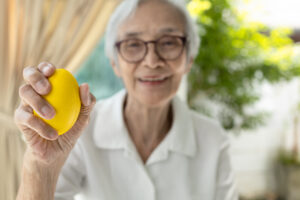Get your body working again.
Simply complete our online request form and one of our intake coordinators will contact you within one business day.
Stroke recovery is a journey that often requires persistence and a personalized therapy program with frequent in-person therapy visits. However, with the advent of remote rehabilitation, or “telerehabilitation,” a new beacon of hope has emerged for stroke survivors who are seeking an alternative to traditional in-person therapy.
Telerehabilitation is an innovative approach that uses different forms of telecommunications technologies to facilitate the delivery of personalized rehabilitation services directly to a patient at home. But what sets it apart? What makes it so compelling for those on the path to recovery?
This article describes what sets remote rehabilitation apart from traditional rehabilitation.
Remote rehabilitation programs seamlessly integrate with your or your loved ones’ lives in the most convenient way possible – at home. A core advantage of telerehabilitation is that it eliminates the barriers of distance and the constraints of a clinic-based schedule.
For stroke survivors who may struggle with transportation or find their physical energy waning, the ability to engage in therapy from the comfort of their living room bridges gaps, particularly for those in rural areas or with limited healthcare resources.
Remote rehab allows patients to meet with a skilled therapist for assessment and therapy visits via secure videoconferencing platforms. Physical therapy, speech-language pathology, and occupational therapy can all be performed in this virtual format.
The transition from traditional outpatient rehabilitation to a remote rehabilitation model represents more than just a shift in location. Many believe that virtual rehabilitation is a shift toward more personalized care. When your living space becomes a rehab clinic, every fork, cup, and clothing stitch transforms into a therapeutic tool.
Mastering activities of daily living post-stroke requires active participation in rehabilitative sessions tailored to harness the brain’s neuroplasticity. Neuroplasticity is the brain’s capacity to reorganize itself based on experiences, and it is pivotal in relearning skills affected by stroke. It enables the brain to adapt and reorganize, facilitating the acquisition of lost skills.
Through guided exercises and real-life simulations, remote rehabilitation ensures that every movement serves a functional purpose and aids in reconstructive efforts post-stroke. For instance, in a telerehab session, a therapist might guide a patient through using utensils to mimic cutting food. Consistent practice stimulates brain activity, enhancing the ability to perform fine motor tasks in a real-world scenario, like using utensils.
Demand for alternatives to traditional in-person post-stroke rehabilitation has increased in recent years. To meet this need, Imago Rehab developed a personal virtual rehabilitation program born out of Harvard University. The remote rehabilitation program is designed for individuals specifically recovering from strokes.
Imago supports stroke survivors at every stage of their recovery journey by blending leading remote rehab technologies with a deep-rooted commitment to patient-centered care to help accelerate progress. The Imago Rehab team uses a combination of technologies depending on the needs of each individual and may recommend one or more of the following:
Research shows that consistent high repetition is key to stroke recovery. Therapists often refer to this as massed practice. Therefore, performing high repetition of the skills or movements that need improvement is necessary. That is why therapy and practicing exercises at home in between therapy appointments are both important.
At the heart of remote rehabilitation lies the strategic use of technology to enrich the therapeutic experience. Full-body neuro rehab devices, such as Flint Rehab’s FitMi and MusicGlove, are excellent examples of how digital tools can foster engaging, precise, and measurable recovery journeys. These devices not only tailor rehabilitation to individual needs but also add an element of enjoyment and motivation. Your Imago team can work with you to help optimize the use of neurorehabilitation devices you may have at home.
Imago’s therapists focus on physical recovery but also foster a sense of empowerment and resilience among stroke survivors. An Imago therapist will create a plan that targets your specific recovery needs and incorporate exercises that encourage massed practice and help you stay motivated to reach your unique goals. With consistency and dedication, your brain can heal itself after stroke.
Everyone has a unique remote rehabilitation recovery story. While each stroke recovery journey is distinct, learning how others overcame their obstacles can be inspiring and comforting.
One favorite telerehabilitation success story is that of Susan, an Imago Rehab patient who suffered a stroke. Here is Susan’s recovery story:
After her stroke, Susan returned to her small town, where she faced significant challenges in accessing specialized stroke rehabilitation. The local clinics, primarily focused on sports medicine, lacked the expertise required for stroke recovery. After almost 18 months of outpatient rehab, Susan had made very little progress in restoring function to her affected arm.

Beyond the physical effects, this lack of progress had a profound impact on her mental well-being, leading her to question whether there was any hope for recovery. Susan’s discovery of Imago Rehab marked a turning point in her recovery. Choosing to engage with Imago’s remote rehabilitation services, she embarked on a personalized therapy plan tailored by expert therapists.
This plan was not just about exercises; it was also about integrating therapeutic activities into her everyday life, transforming mundane tasks into opportunities for rehabilitation. The results were nothing short of transformational. Susan gained many new skills, significantly improved the functionality of her affected arm, and, most importantly, restored her belief in the possibility of recovery.
If you explore telerehabilitation, collaborate closely with your medical team and therapists to develop a personalized telerehabilitation plan that aligns with your goals. With dedication and consistent repetition, you take daily steps toward enhancing your independence and achieving your goals.
Simply complete our online request form and one of our intake coordinators will contact you within one business day.